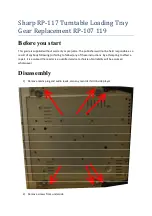
below that relates to your case.
Single earth wire on tonearm lead-outs
If your arm has a single earth lead, try connecting the
blue tonearm earth wire to the
first
component in the
chain from the arm. For example if you have a phono
stage connected to an integrated amp, then connect the
arm earth wire to the phono stage. On some amplifiers
it's best to leave the arm earth disconnected to reduce
hum.
3 Blue Earth wires and a Black signal return earth
wire on tonearm lead-outs
If your arm has the configuration shown opposite, try the
following and settle for the configuration with least hum.
A) Connect only the wire denoted “arm earth” and leave
the “screen earths” and “black wire” disconnected.
B) Connect all 3 blue earth wires to earth.
Connect “2 blue screen earths” only and leave arm earth
disconnected.
If hum still persists disconnect blue wires from earth and
connect only the thin black wire sprouting from the
“white RCA plug” to the phono earth.
Then try the options A to C but with the black wire
connected.
This process does not take long and is only necessary if
you experience hum.
Additional notes on connections
Avoid pulling the external wires at the base of the arm as
they are not indestructible and can become detached if
excessive force is used to manipulate them. This also
applies to the cable joints in the phono plugs.
If you have XLR plugs, you will not get both plugs
through the mounting hole for the arm. The hole is too
small to allow the 2nd plug to go through as the 1st
cable wire takes up space.
For this reason we normally fit only one XLR plug
and leave you to fit the other. Full instructions on
how to fit the other XLR are available on our web
site - see top navigation bar > Support > Solving
problems > Tone-arms then scroll down to near end
of page.
Fit Cartridge
If you're not familiar with fitting cartridges then
please read the detailed section “Hi-Fi Cartridges
explained” found towards the end of this manual.
Mounting
Mount the cartridge in the headshell using
mounting screws (usually 2.5mm allen bolts).
At this stage the headshell screws should be just
tensioned sufficiently to hold the cartridge against
the headshell, but loose enough for the cartridge to
be rotated and moved.
Set the initial position of the cartridge with
mounting bolts approximately midway along the
slots as shown below.
Carry out the set up procedure outlined below
without deviating from sequence. Each step affects
the next — change the order and setup will be
wrong.
Notes on cartridge mounting
Once cartridge is later aligned, mounting bolts
should be tight. Stainless steel Allen bolts are best
for mounting cartridges – the aluminium or brass
ones supplied with some cartridges are OK but
difficult to tighten in comparison to Allen heads.
Avoid steel bolts as they are magnetic and degrade
your cartridge magnets.
It's safest to fit the cartridge with the stylus guard in
place but it may be necessary to remove for phases
of installation. If you do so, replace it as soon as
possible.
Page 3
INITIAL POSITION OF CARTRIDGE





























